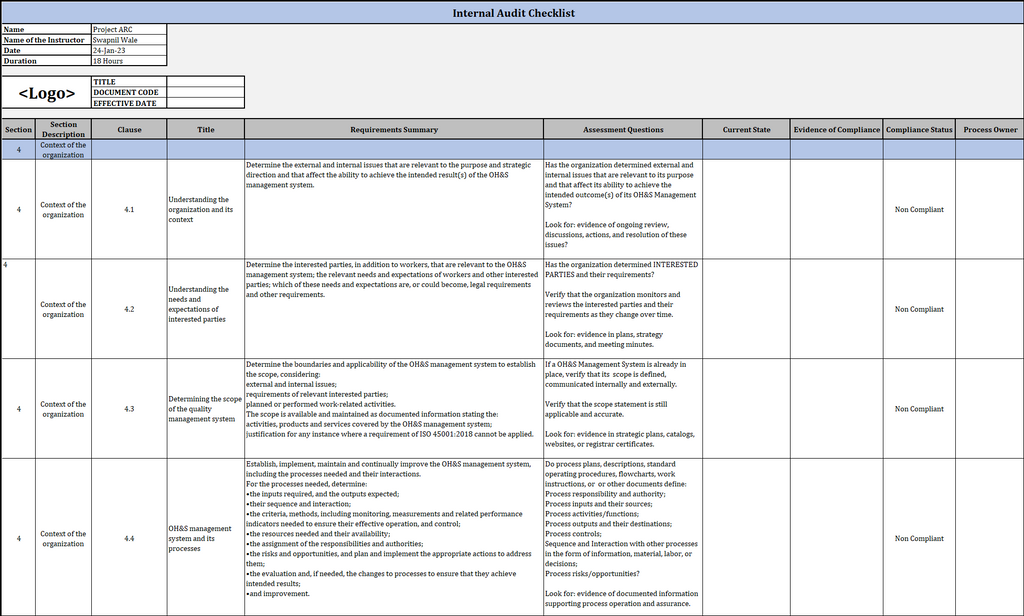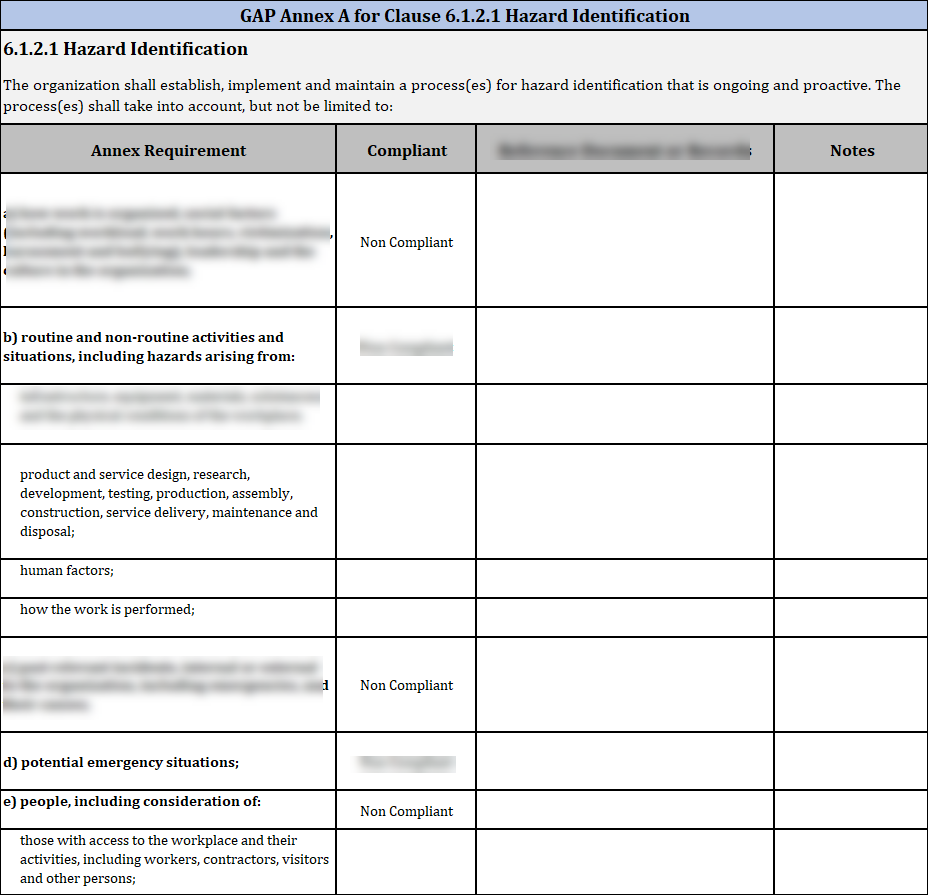ISO 45001 Internal Audit Checklist Template
Introduction
Internal audits are essential to maintaining compliance with ISO 45001 standards for occupational health and safety management systems. To ensure that your organization effectively manages workplace risks and hazards, it is crucial to have a comprehensive internal audit checklist in place. This template will provide a step-by-step guide on conducting internal audits to meet ISO 45001 requirements. By utilizing this checklist, your organization can identify areas for improvement, increase safety performance, and ultimately achieve ISO 45001 certification.

Understanding The Importance Of Internal Audits For ISO 45001 Compliance
Internal audits are a crucial component of achieving and maintaining ISO 45001 compliance. ISO 45001 is an international standard for occupational health and safety management systems, and internal audits are a vital tool for ensuring that an organization's health and safety management system is effective and functioning as intended. Internal audits involve a systematic review of an organization's health and safety processes, procedures, and controls to identify areas of non-compliance and opportunities for improvement.
By conducting regular internal audits, organizations can proactively identify and address potential health and safety risks, non-conformities, and areas for improvement before they lead to accidents, injuries, or regulatory violations. Internal audits also help organizations demonstrate their commitment to health and safety management to stakeholders, customers, and regulatory authorities. By maintaining detailed records of internal audit findings and corrective actions, organizations can provide evidence of their compliance with ISO 45001 requirements and dedication to continually improving their health and safety performance.
Internal audits are critical in ensuring organizations comply with ISO 45001 requirements, proactively manage health and safety risks, and continuously improve their health and safety management systems. Organizations prioritizing internal audits as part of their compliance efforts are better positioned to protect their employees, prevent accidents and injuries, and enhance their overall business performance.
Implementing A Practical Internal Audit Checklist For ISO 45001
1. Leadership And Commitment
- Is top management committed to implementing and maintaining an effective occupational health and safety management system?
- Does top management demonstrate leadership in promoting a positive safety culture within the organization?
2. Policy And Objectives
- Has the organization established and communicated its occupational health and safety policy to all relevant stakeholders?
- Are measurable objectives and targets set by the organization to improve occupational health and safety performance?
3. Roles And Responsibilities
- Are roles, responsibilities, and authorities clearly defined and communicated regarding occupational health and safety for all employees?
- Is a designated management representative responsible for overseeing the occupational health and safety management system?
4. Competence And Training
- Are employees adequately trained and competent to perform their tasks safely?
- Is there a training program in place to ensure that employees understand their roles and responsibilities related to occupational health and safety?
5. Communication And Consultation
- Are there processes for effective communication and consultation with employees on health and safety matters?
- Does the organization provide opportunities for employees to raise safety concerns or make suggestions for improvement?
6. Hazard Identification And Risk Assessment
- Has the organization identified all potential hazards within the workplace and assessed the associated risks?
- Are controls in place to eliminate or mitigate the identified hazards to prevent injury or illness?
7. Legal And Other Requirements
- Is the organization aware of and compliant with all relevant occupational health and safety legal requirements and other obligations?
- Are procedures in place to monitor and review changes in legislation related to occupational health and safety?
8. Incident Investigation And Corrective Actions
- Are incidents, accidents, and near-misses investigated promptly to determine root causes and implement corrective actions?
- Is there a process in place to track and follow up on corrective actions to prevent the recurrence of incidents?
9. Performance Evaluation
- Are performance indicators established and monitored to evaluate the effectiveness of the occupational health and safety management system?
- Are internal audits and management reviews conducted regularly to assess the system's performance and identify areas for improvement?
10. Continual Improvement
- Is the organization committed to improving its occupational health and safety performance?
- Are there mechanisms in place to capture feedback, evaluate opportunities for improvement, and implement changes to enhance safety outcomes?
Ensuring Continual Improvement Through Internal Audits
1. Management Commitment: Senior management has demonstrated a solid commitment to health and safety by actively participating in safety meetings and providing necessary resources for implementing safety initiatives.
2. Hazard Identification: The hazard identification process is well-established, and employees are actively involved in identifying and reporting hazards in the workplace.
3. Risk Assessment: Risk assessments are conducted regularly to assess and control workplace risks. However, there is room for improvement in documenting risk assessment results and implementing control measures.
4. Employee Training: Employees have received adequate training on health and safety procedures, but refresher training is needed to ensure continued awareness and compliance.
5. Emergency Preparedness: Emergency response procedures are in place, but regular drills and simulations are needed to test their effectiveness.
6. Incident Reporting: The incident reporting process effectively captures incidents and near misses, but there is a need for timely investigation and implementation of corrective actions.
7. Performance Monitoring: Key performance indicators are tracked to monitor the effectiveness of the Health and Safety Management System. However, there is a need for regular review and analysis of performance data to identify trends and areas for improvement.

Best Practices For Using The Internal Audit Checklist Template
1. Make sure to thoroughly review the internal audit checklist template before beginning the audit process to ensure it meets the requirements of ISO 45001.
2. Customize the checklist template to fit your organization's specific needs and processes. This may include adding or removing sections or adjusting the evaluation criteria.
3. Develop a clear and detailed audit plan that outlines the audit's scope, objectives, and timeline.
4. Train all internal auditors on using the checklist template and guide them on effectively conducting the audit.
5. Use the checklist template as a guide during the audit process, but also be prepared to ask additional questions and gather more information as needed.
6. Record all findings, observations, and recommendations clearly and organized on the checklist template.
7. Communicate the audit results to relevant stakeholders, including management, and work with them to develop and implement action plans to address any identified non-conformities or opportunities for improvement.
8. Regularly review and update the internal audit checklist template to ensure it remains accurate and effective in monitoring and improving your organization's occupational health and safety management system.
Conclusion
In conclusion, utilizing an internal audit checklist for ISO 45001 is vital in ensuring compliance with occupational health and safety standards. This template provides a comprehensive guide for conducting internal audits effectively and efficiently. By consistently using this checklist, organizations can identify areas for improvement and ensure continuous compliance with ISO 45001 requirements. Download the Internal Audit Checklist for ISO 45001 Template today to enhance your occupational health and safety management system.


